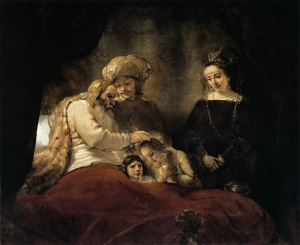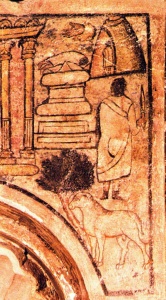Bezalel’s Legacy: Commentary on Jewish Craft and Art
Bezalel, oh Bezalel, what company you keep! Your parsha, Ki Sisa, takes us from humble devotion to God’s commandments to the utter collapse of Israel’s faith. God inspired creativity morphs into pernicious communal idolatry that expressed gnawing doubt and a desperate need for the mechanics of teshuvah. Yet in the midst of tragedy, drama and redemption one quiet man and his assistant, Bezalel and Oholiab, were chosen by God to become the alleged ancestors of all Jewish artists.

Art is by its nature contemplative and contentious. Its primary purpose is to stimulate the viewer to think about something beyond the art object itself. Art is a medium to pass through. Rembrandt’s iconic Jacob Blessing the Children of Joseph (1656) reinterprets the text, showing only the blessing of Ephraim, the younger son. But even more exceptional is Rembrandt’s inclusion of Joseph’s wife, Asenath, who is nowhere found in this passage. Her role here is a revelation. According to the midrash (Pirke de Rabbi Eliezer 38) after Dinah’s rape she had a daughter, Asenath. The shame for the family was too great and so she was sent away by Jacob himself and finally adopted in Egypt by Potiphar and his wife. In Rembrandt’s image here she stands before Jacob, her grandfather, and her mother’s tragedy is somehow comforted; now returning to her family with the blessing of her children, the future of the Jewish people. This powerful interpretative role of art is equally true of narrative representations, abstractions and conceptual works that evoke emotions and stimulate intellectual engagement. Craft is different.

A beautiful kiddush cup is a wonder in itself, calling attention to the object and its ritual use. The same was true of the objects Bezalel made for the Mishkan: the physical structure, the Aron, the Showbread Table, the Menorah and even the Priestly garments. From architecture to sacred fashion these ritual objects were participants in the Avodah whose primary meaning rested in the ritual, not in what was used to perform it. As central to the worship of God they took on an aspect of sanctity unimaginable for a work of art. So it is true with the objects of Jewish Craft that we use today. A similar transformative effect is felt in the 1998 Spice Box for Havdalah by Malka Kohavi. This witty design blends the functionality of a stem pierced with dozens of holes and the metaphor to stop and smell the rose; to ponder the passing of Shabbos and the beginning of the workweek. A Torah mantle or Ark Curtain has sanctity in themselves by virtue of their use and proximity to the Torah scroll. Once worn out or damaged they must be buried with a same respect as a Torah. Art has another agenda.

Art does not come naturally to Judaism, rather it is almost certainly adopted from the Greco-Roman world. The decorations in early synagogues evidenced by the Dura Europos murals (235 CE) or the Beit Alpha mosaics (518 CE) are cultural imports. But as such they were totally Judaized. The images produced are obsessed with meaning and not ritual. And while initially decorative they refer to the undercurrent of textual commentary and midrashim that were forever heard in the background and that always inform our sacred texts. The Akeidah found above the Torah niche at Dura Europos, the very earliest image we have of the subject, mysteriously presents a figure in the tent doorway in the upper right. Who is it: Sarah, Eliezar, Ishmael? This foreign element forces us to reconsider what we always assumed about the Akeidah and come away with an alternative meaning. Art is a gateway into intense textual analysis and emotional involvement in narrative and meaning. The images of Jewish Art are not expressions of the will of God, rather they are our attempt to understand the complexities and contradictions of Divine command. Jewish Art in this context is Talmud Torah, a visual Midrash whose purpose is to pose questions and raise issues. Conversely ritual and its beautiful ritual objects must provide certainty.
Nonetheless, there is much to be learned from our parsha about Jewish Art. The ideal ethical and spiritual qualities of Jewish Art and Jewish Craft are identical because we hope for equal refinement and intention in our ritual objects and in our art. We want the best whether the purpose is to worship or study. Since the Torah knows this, why should it juxtapose the elevated mission of Bezalel with the most grievous sin of the Golden Calf? There’s the rub.
The warning that Ki Sisa presents is about the nature of objects, ritual objects that we invest with too much meaning, in fact fall in love with and forget the ultimate incorporeal reality of our God.
When we doubt the verity of Divine promise and command, we second-guess the existence of our Creator. And the first thing we make is an alternative ritual object as a way to serve the transcendental God concretely. Our desire for God to be manifest became an idol in the form of the Golden Calf. We fashioned it as a way to certainty. And looking for an assurance of faith, a comfort of that which is substantive, we erred, in fact we sinned. It becomes Bezalel perverted. It is the sin of the object.

As Rashi tells us (Exodus 31:18), there is no necessary chronology in the Torah, and actually the incident of the Golden Calf preceded the work of the Tabernacle done by Bezalel. Therefore God’s command to Bezalel can be seen as a response to our deep need for some kind of objective certainty. God tells us to make ritual objects that will be used to serve Him. That is permitted. But when our doubt and fear about the absent God and his servant Moshe provoked the creation of the Golden Calf; God gave us the tools to do teshuvah in the Thirteen Attributes of Mercy as Moses ascended the mountain a second time. Each attribute is a revelation into the mysterious nature of the unseen God. Even here Jewish Art can provide insight. Right before this, Moses boldly asks to see God’s Glory and God places him in a cleft of the rock as He passes by. My 2006 painting God Passes By captures the moment after the miraculous event. While Moses could not have survived seeing God’s Glory, yet a glimpse of His “back” was sufficient to inspire him for the rest of his life. Our God demands faith and yet provides us with precious concrete hints as how to serve Him and how to know Him. Jewish Craft and Jewish Art have a hand in both.
Bezalel’s Legacy
Commentary on Jewish Craft and Art
Shabbos Parah: Ki Sisa; Exodus 30:11-34:35